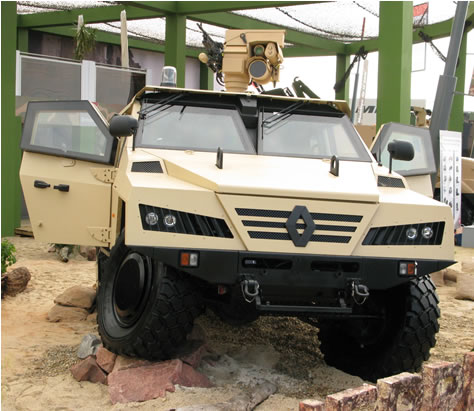This year Eurosatory 2008 land, airland and homeland exhibition hosted some 1,210 exhibitors from 52 countries, 120 delegations of senior military and government executives from 80 countries, and record attendance of over 50,000 visitors from all over the world, the exhibition established itself at the premier place of the world’s land forces professional events.
 Although topics covered at the show were wide and diversified, a common thread linking many displays, especially those of NATO member countries – was the preoccupation with force protection. Armored vehicles are becoming bigger, slower and less maneuverable, applied with tons of steel armor and composites protecting against roadside bombs RPGs and IEDs.
Although topics covered at the show were wide and diversified, a common thread linking many displays, especially those of NATO member countries – was the preoccupation with force protection. Armored vehicles are becoming bigger, slower and less maneuverable, applied with tons of steel armor and composites protecting against roadside bombs RPGs and IEDs.
These attacks are launched sporadically but effectively by fearless insurgents, equipped with rudimentary, but highly effective weapons and natural fighting skills and stealth, blending effectively in desert, rural or urban terrain. In contrast, NATO forces are still employed with ‘high signature’ posture, surrounded by the heavy protected vehicles and body armor, troops are less likely to develop natural ‘warrior skills’, as they tend to relying more on synthetic video-game style sensor fusion, rather than human instincts, inevitably earned entirely by combat experience.
To fill this sensory gap armies seek the help of sophisticated sensors and electronic systems which, when sensibly employed, have the potential to earn significant advantage over an unsophisticated enemy.
Peripheral and panoramic vision systems enable troops inside armored vehicles to look ‘through’ the armor, effectively monitoring their surroundings to detect suspicious hostile activities, automatically slaving remote controlled weapon to challenge potential threats. Similarly, relying on early warning, Forward Operating Bases (FOB) are surrounded by ground bound elevated sensors, aerostat-borne and mast- mounted, their peripheral area scattered with unattended ground sensors, while mini-UAVs swarm the sky to protect the forces in those hostile land.
Advanced imagery and electronic sensors operating with intelligence reconnaissance and surveillance (ISR) systems enable those forces to gain technological superiority, fight back and regain some of the agility and surprise normally lost on routine patrols. With effective ISR forces are capable of outmaneuver and outperform their enemies, by shortening the ‘kill chain’ between the detection of hostile elements and their elimination by precision guided weapon. New targeting equipment associated with ground and airborne elements enable joint forces to focus precision effects from different platforms, including airborne, artillery, tanks and mortars, to defeat enemy targets and repel hostile attacks from standoff range, before the enemy have time to take cover or regroup.
The devastating experience suffered by the Israeli Army in Lebanon two years ago, accelerated the development of active defense systems (ADS), for heavy as well as medium and light vehicles. ADS are becoming a standard with the IDF latest MBTs and AIFVs, as well as part of the basic protection suite of modern families of vehicles, such as the British FRES and U.S. Army FCS. At Eurosatory, some ADS developers presented new designs adapted for light APCs and even light utility vehicles. However, given their ‘violent effect’ of such engagement, some experts doubt the applicability of blast, high explosive based and other close-in ADS for light vehicles, suggesting that the residual level of kinetic energy maintained by the intercepted munition (such as RPG) is enough to kill such soft target regardless of the condition of the intercepted warhead.
 Integrated Soldier Systems being developed by many of the modern armies represent a departure of this defensive, passive trend, aiming at regaining the initiative by employing flexible teams of ‘network enabled warfighters’ overwhelming an opponent by firepower, maneuver and surprise. While defense manufacturers are prepared to offer such systems, the infantry users are less confident in the usability of overly sophisticated systems in actual combat. This hesitation led to the realization and fielding of less sophisticated systems by the British, German, French and U.S. forces, in support of ongoing operational deployment in recent months. Currently supported applications range from situational awareness, dismounted C4ISR, sniper detection, reporting and operations of unmanned sensors in exceptionally high threat situations such subterranean surveillance. As systems are matured and gain user confidence, soldier systems are expected to expand to a wider use with infantry units worldwide.
Integrated Soldier Systems being developed by many of the modern armies represent a departure of this defensive, passive trend, aiming at regaining the initiative by employing flexible teams of ‘network enabled warfighters’ overwhelming an opponent by firepower, maneuver and surprise. While defense manufacturers are prepared to offer such systems, the infantry users are less confident in the usability of overly sophisticated systems in actual combat. This hesitation led to the realization and fielding of less sophisticated systems by the British, German, French and U.S. forces, in support of ongoing operational deployment in recent months. Currently supported applications range from situational awareness, dismounted C4ISR, sniper detection, reporting and operations of unmanned sensors in exceptionally high threat situations such subterranean surveillance. As systems are matured and gain user confidence, soldier systems are expected to expand to a wider use with infantry units worldwide.
The following topics are included in our Eurosatory 2008 focus:

























